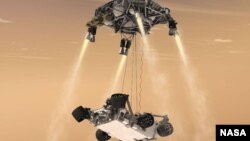The U.S. space agency has landed a rover on Mars, completing the most harrowing step in a mission to investigate possible life on the planet.
Mission controllers at NASA's Jet Propulsion Laboratory erupted in cheers after confirming that the one-ton rover called Curiosity arrived on Mars after an eight-month journey. The first pictures from the craft were received back on Earth almost immediately after confirmation of the landing Monday at about 0530 UTC.
NASA scientists called it the most challenging landing they have ever attempted.
The Curiosity rover is the centerpiece of NASA's $2.5 billion Mars Science Laboratory mission. Curiosity traveled nearly 570 million kilometers since it was launched in November.
Mission controllers at NASA's Jet Propulsion Laboratory erupted in cheers after confirming that the one-ton rover called Curiosity arrived on Mars after an eight-month journey. The first pictures from the craft were received back on Earth almost immediately after confirmation of the landing Monday at about 0530 UTC.
NASA scientists called it the most challenging landing they have ever attempted.
The Curiosity rover is the centerpiece of NASA's $2.5 billion Mars Science Laboratory mission. Curiosity traveled nearly 570 million kilometers since it was launched in November.
NASA officials told reporters at a pre-landing news conference Sunday that the spacecraft was functioning properly as it sped toward its target.
Adam Steltzner is the lead mechanical engineer for the rover's critical entry, descent and landing sequence. "It's a little anxiety provoking, but I will say that I slept better last night than I have slept in a couple of years because she's kind of on her own now. And when I look back at the hard work that we've done, I believe that the team has done everything that we can to deserve success tonight. Although, as we all know, we can never guarantee success," he said
.
.
Five Things About NASA's Mars Curiosity Rover
-
How Big Is It?: At 2.8 meters long, the Mini Cooper-sized rover is much bigger than its rover predecessors, Spirit, Opportunity and Sojourner.
-
Landing: Where and How: Curiosity will land near the foot of a mountain taller than Pike's Peak near the middle of Gale Crater, which is the size of Connecticut and Rhode Island combined.
-
Toolkit: Curiosity will use 10 science instruments to examine rocks, soil and the atmosphere.
-
Big Wheels: Each of Curiosity's six wheels has an independent drive motor. The two front and two rear wheels also have individual steering motors. The wheels' diameter is double the wheel diameter on Spirit and Opportunity, which will help Curiosity roll over obstacles up to 75 centimeters high.
-
Rover Power: A nuclear battery will enable Curiosity to operate year-round and farther from the equator than would be possible with only solar power.
Courtesy NASA - Click for More
Curiosity was traveling at about 20,000 kilometers per hour when it hit the thin Martian atmosphere. It then had only seven minutes to use a parachute, rocket thrusters and a skycrane to reduce its speed and make a safe landing.
Throughout that period, the craft functioned autonomously. NASA engineers were not be able to witness the events in real time because it takes 14 minutes for radio signals to reach Earth from Mars.
NASA's Adam Steltzner said the scientists and engineers overseeing the project were "rationally confident, emotionally terrified" and prepared. "As far as the amount of control that the team has during entry, descent and landing, it's identical to the control that anybody watching at home has. We're all along for the ride," he said.
Curiosity's hazard-avoidance cameras began taking pictures shortly after touchdown. NASA received the first low-resolution, black-and-white images within minutes of landing.
Doug McCuistion is the Director of NASA's Mars Exploration Program. He says the car-sized rover, which has 17 cameras, will soon provide color pictures. "In the days, years, weeks to come, there is going to be an enormous number of images, incredible images, color images, real color this time, too, so kind of like the human eye will see, which will be really exciting. Those will come, and there will be plenty of those," he said.
The main goal of the mission is to see whether Mars ever had conditions that could have supported microbial life. The nuclear-powered Curiosity is outfitted with instruments to investigate Martian geology, weather and radiation levels during the next two years.
Curiosity is the seventh NASA spacecraft to land on the Red Planet.








